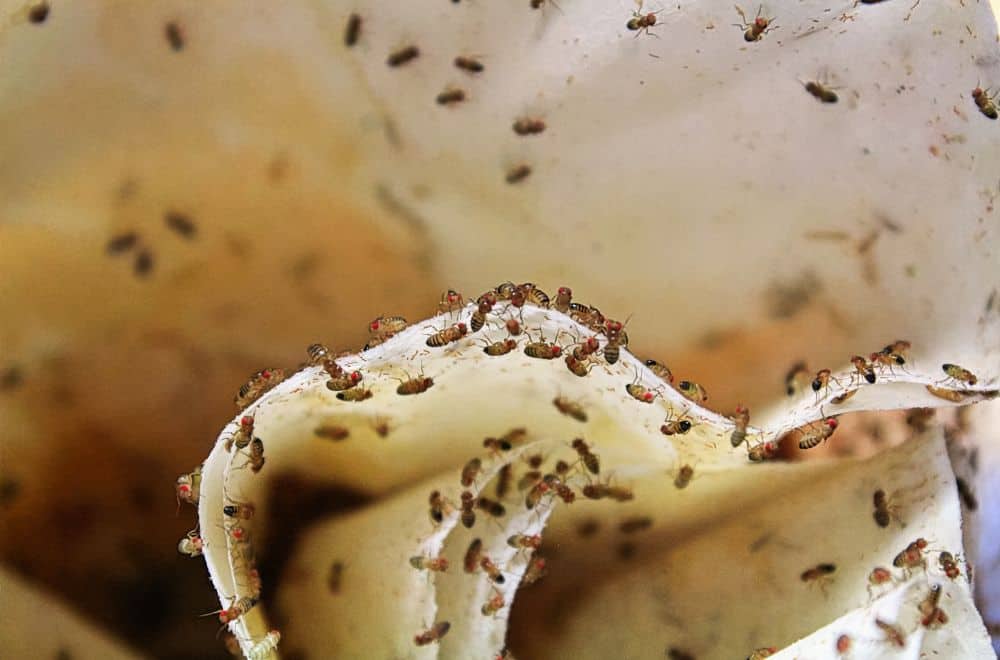Sometimes, you can see small black flying bugs in the house, not Fruit flies. They remind Fruit flies and are typically harmless but can be annoying or look unpleasantly. However, some can transmit bacteria and jeopardize your health.
In some cases, you can face insect infestations that require immediate reaction and solving the problem. Remember that ignoring these insects won’t help, and the only solution is to find a way to eliminate them. However, the only way to finish this task successfully is to identify them first.
Small black flying bug types in the house |
||
| Type | Length | Color |
| No-see-ums | 0.04 to 0.12 inches
(1 – 3 mm) |
Dark grey to black |
| Fungus gnats | 0.06 to 0.12 inches
(1.5 – 3 mm) |
Grayish-black |
| Mosquitoes | 0.1 to 0.4 inches
(2.5 – 10 mm) |
Dark gray with white, green, silver, or iridescent blue scales |
| Drain flies | 0.12 to 0.16 inches
(3 – 4 mm) |
Dark brown to black |
| Carpet beetles | 0.12 to 0.19 inches
(3 – 4.8 mm) |
Shiny dark brown and black |
| House flies | 0.17 to 0.25 inches
(4.2 – 6.3 mm) |
Dull gray with black stripes |
| Flying (winged) termites | 0.25 to 0.37 inches
(6.3 – 9.4 mm) |
Dark brown to black |
| Winged ants | 0.75 inches (19 mm) | Reddish-brown or black |
Fruit Fly-look Small Black Flying Bugs In the House
1. No-see-ums (Sand flies, Biting midges, Biting gnats)
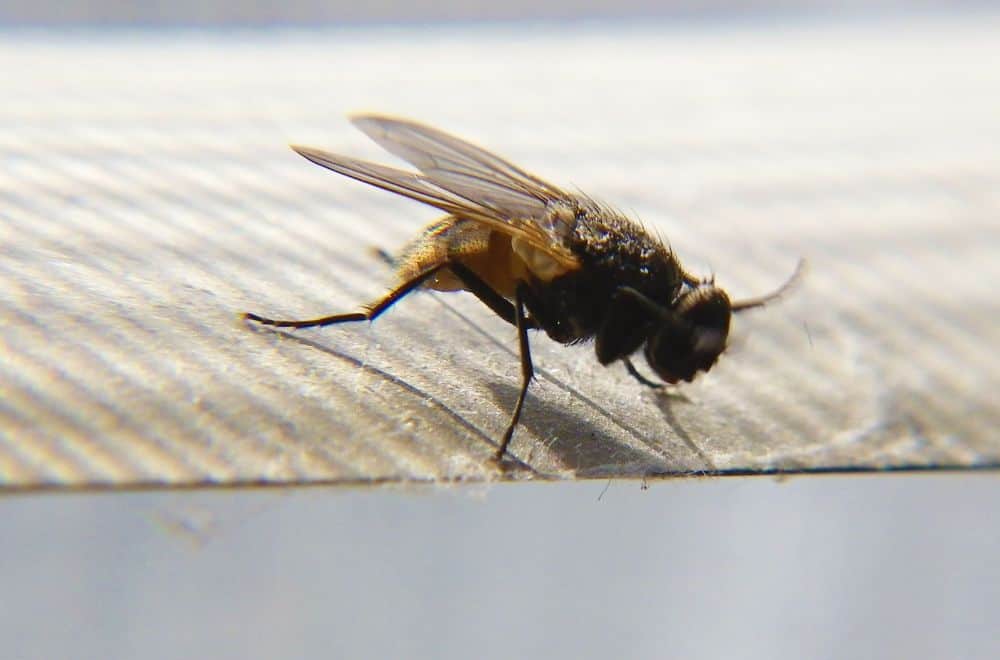
Dark grey to black No-see-ums are tiny, 0.04 to 0.12 inches (1 – 3 mm) long biting midges. Even though they are among the smallest insects on the list of Fruit fly-looking small black bug types in the house, they are undoubtedly the most irritating.
These bugs feed on plant nectar and look for moist places to lay eggs. Therefore, you can find them in the garden, forest, and near ponds. Because of their size, the infestation is often invisible and unnoticed until it is too late.
Their blood-sucking females are particularly annoying. You can feel their bites and see marks on your skin but without the possibility of noticing insects. Luckily, they are incapable of transmitting diseases to humans.
2. Fungus gnats
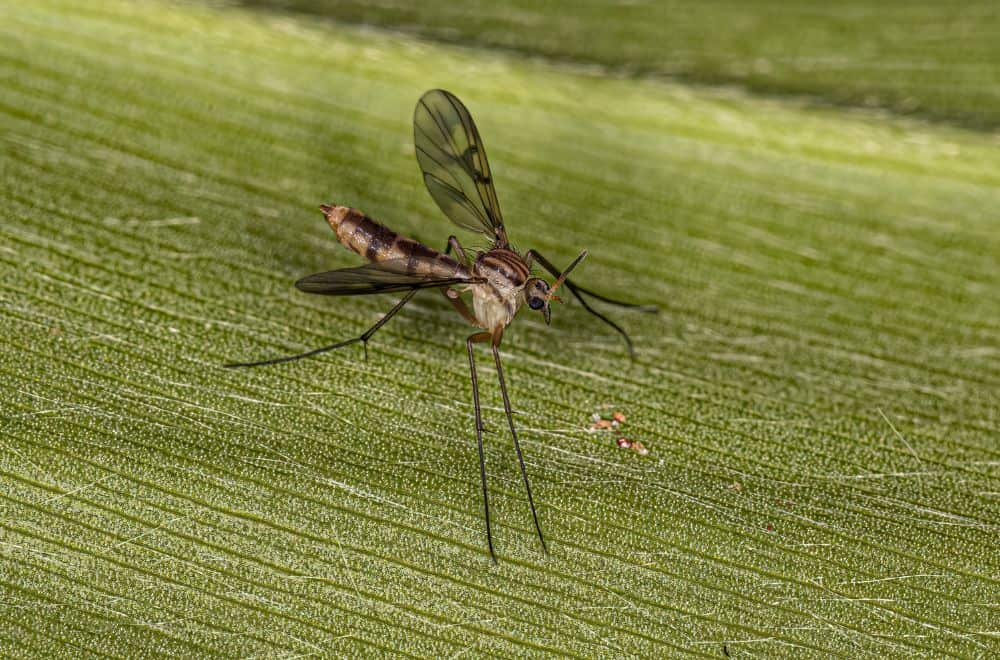
Fungus gnats are grayish-black insects about 0.06 to 0.12 inches (1.5 – 3 mm) long. Even though these insects are harmless to humans and pets and never bite, they can be pretty annoying while flying around your head.
You can often spot them near water sources, compost piles, and potted leafy plants, particularly when overwatering them. They will gather around your plants and damage them eventually.
House owners often confuse them with Fruit flies because of numerous physical similarities, but there are a few significant differences.
Long-legged Fungus gnats never fly quickly but typically hover around plants or stay on the ground. They live for a month and promptly reproduce, so you should eliminate them as soon as possible. Once larvae appear, you will have a problem getting rid of them.
3. Mosquitos

Mosquitos are typically 0.1 to 0.4 inches (2.5 – 10 mm) long insects with dark gray, almost black bodies. These irritating blood-sucking bugs are opportunistic pests that make home infestation unbearable.
Be aware that stagnant water and high humidity attract Mosquitos. Therefore, your only hope to eliminate them is to destroy their habitats, like leaking pipes, damp showers, and stagnant water in gardens.
Always add a drop of dish soap to a vase with flowers to prevent larvae from growing. No worries, this method won’t hurt your plants.
4. Drain flies
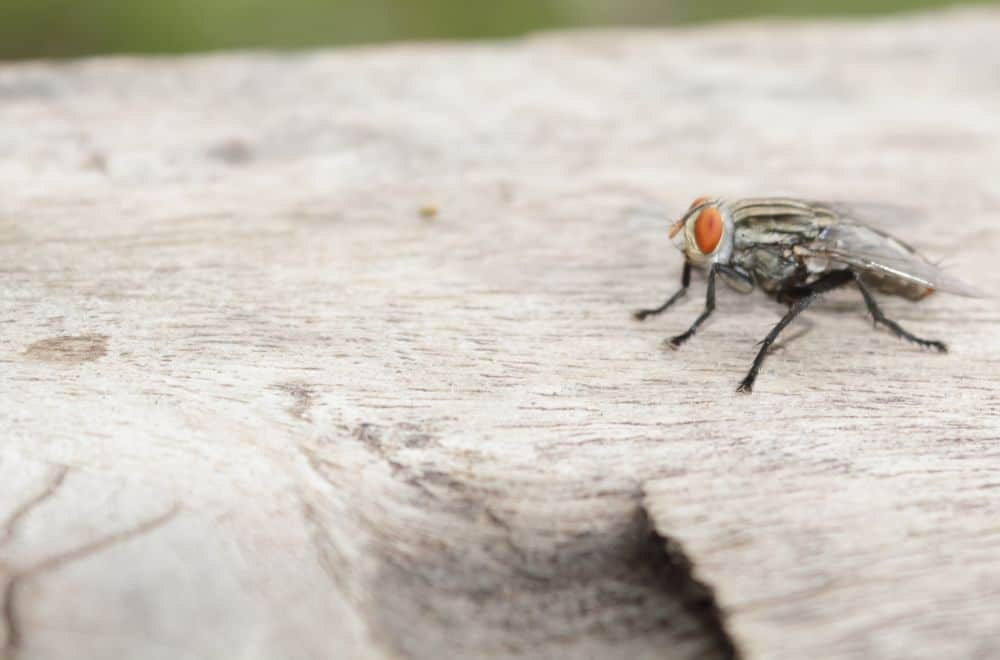
Unlike smaller, brownish Fruit flies with red eyes, Drain flies are dark brown to black. These insects are 0.12 to 0.16 inches (3 – 4 mm) long. Even though they feed on bacteria and fungi and are harmless to humans and animals, they are incredibly annoying.
Drain flies’ lifespan is 8 to 24 days, but their females lay approximately 300 eggs in two days! That makes these bugs highly invasive.
They typically swarm and spend time in moist environments, notably near food sources, drains, and sewers. Since they breed in dirty water, keeping your sink, pipes, and drains clean is the only way to eliminate them.
5. Carpet beetles
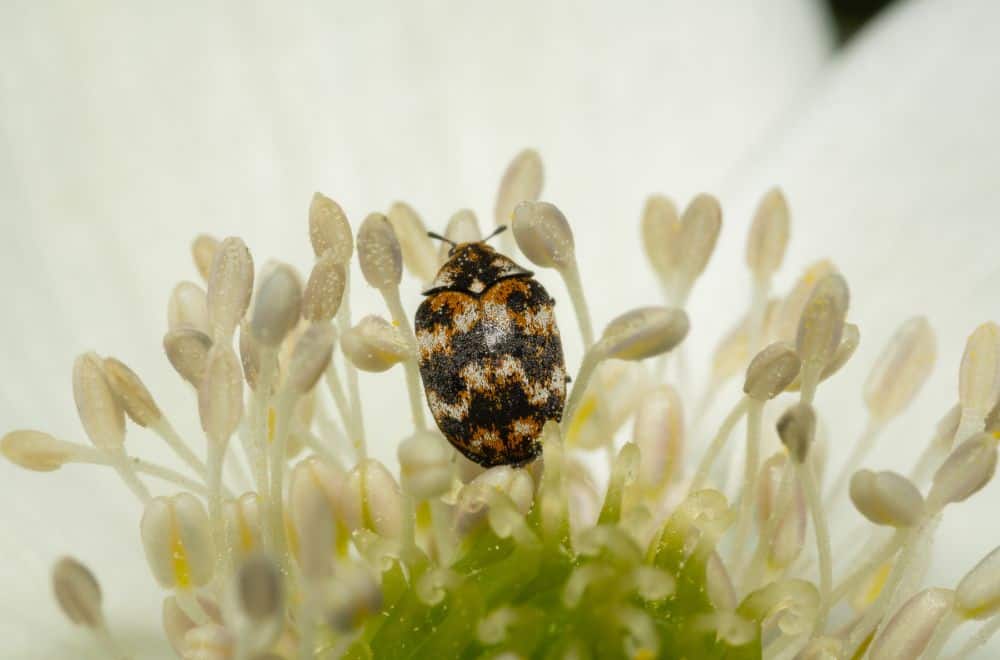
Carpet beetles are approximately 0.12 to 0.19 inches (3 – 4.8 mm) long and have shiny dark brown and black bodies. Besides invading your living room and bedroom, you can find them in the kitchen, pantry, and among dirty laundry and bed sheets.
Their larvae feed on animal products, so they successfully damage clothes and other items made of organic fabrics, like:
- Silk scarves and kimonos
- Wool sweaters and dresses
- Leather jackets and footwear
- Wool carpets
Eliminating these irritating pests as soon as you notice them is necessary because they are a real threat to your home. The most efficient way is to keep sheets and clothing clean and steam clean your carpets. In the worst case, you can apply a quality and proven chemical product and kill all the bugs.
6. Houseflies
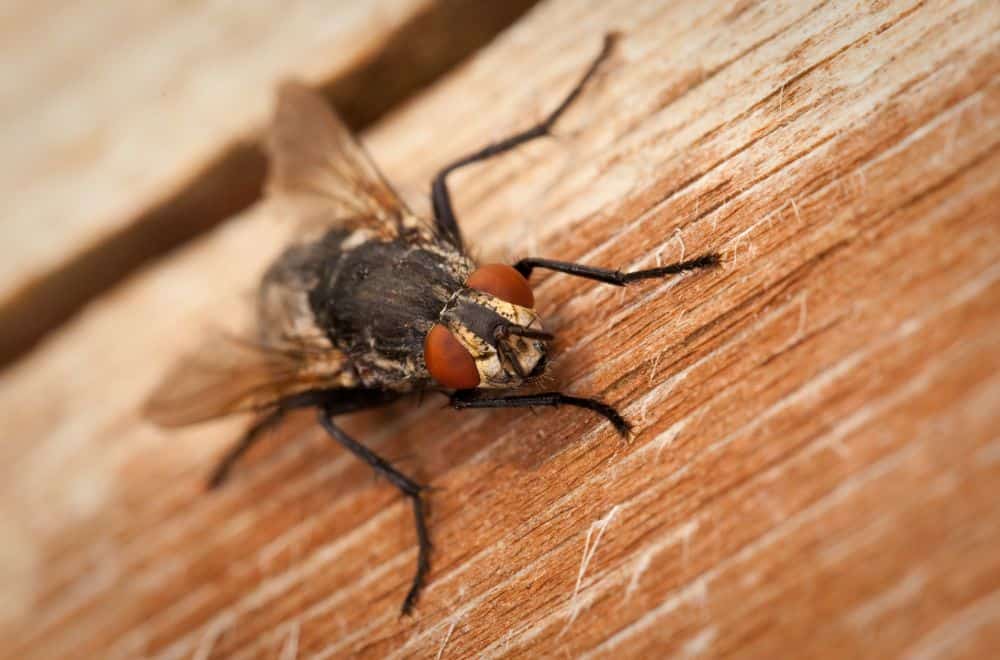
Houseflies are irritating, 0.17 to 0.25 inches (4.2 – 6.3 mm) long insects with complex eyes. They are present worldwide, including in the Arctic, and you can find them spending time indoors and outdoors equally.
Adults live approximately 15 and 30 days. Females lay about 600 eggs at once and can do it practically anywhere. It is almost impossible to prevent them from entering your home, so your only chance to avoid an infestation is to destroy breeding grounds.
You can find them at any place with rotting food and garbage. Scientists suspect house flies mechanically transmit about 65 diseases to humans, including cholera, dysentery, typhoid fever, and food poisoning.
7. Winged termites (Swarmers, Alates)
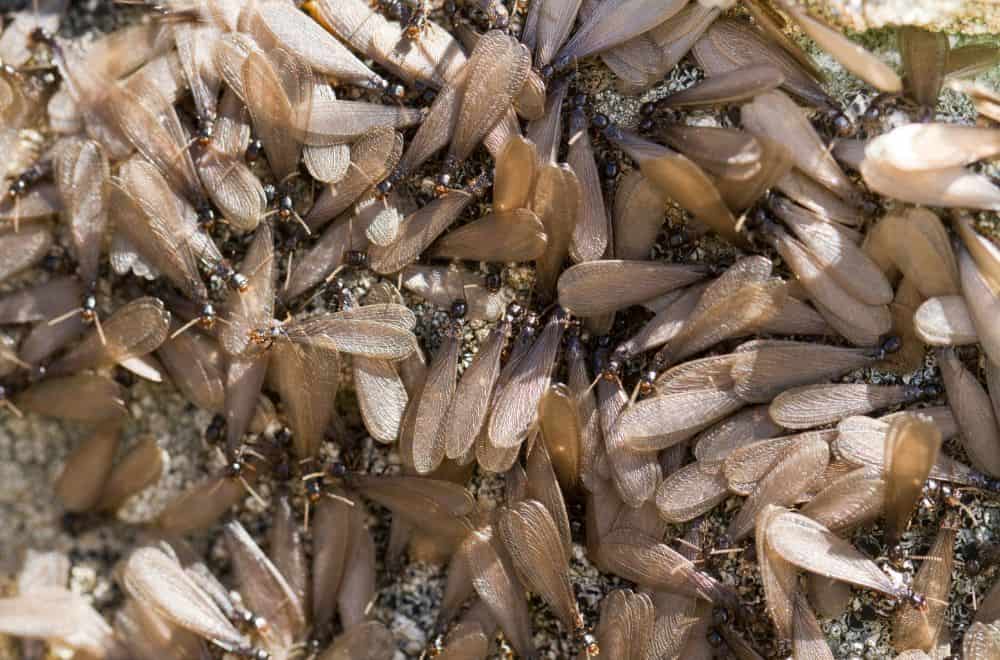
Flying termites are 0.25 to 0.37 inches (6.3 – 9.4 mm) long dark brown to black insects. These winged creatures are actually the subterranean termites‘ adult reproductive form.
When conditions are adequate, Swarmers develop inside the colony and leave their nests to mate. Their goal is to produce new generations and start new colonies. Homeowners often confuse these insects with Fruit flies, but termites have two wing pairs and segmented bodies. Plus, they never swarm in large numbers.
You can be sure that you have a problem with termite infestation when noticing these tiny bugs flying inside your home in the spring and summer. Left alone, they can cause structural issues and ruin your house by eating wood and other materials.
Be aware that you can’t do much yourself, so calling an exterminator is the only way of eliminating these destructive insects. The only good news is that they neither bite humans nor spread diseases.
8. Winged ants (Alates)
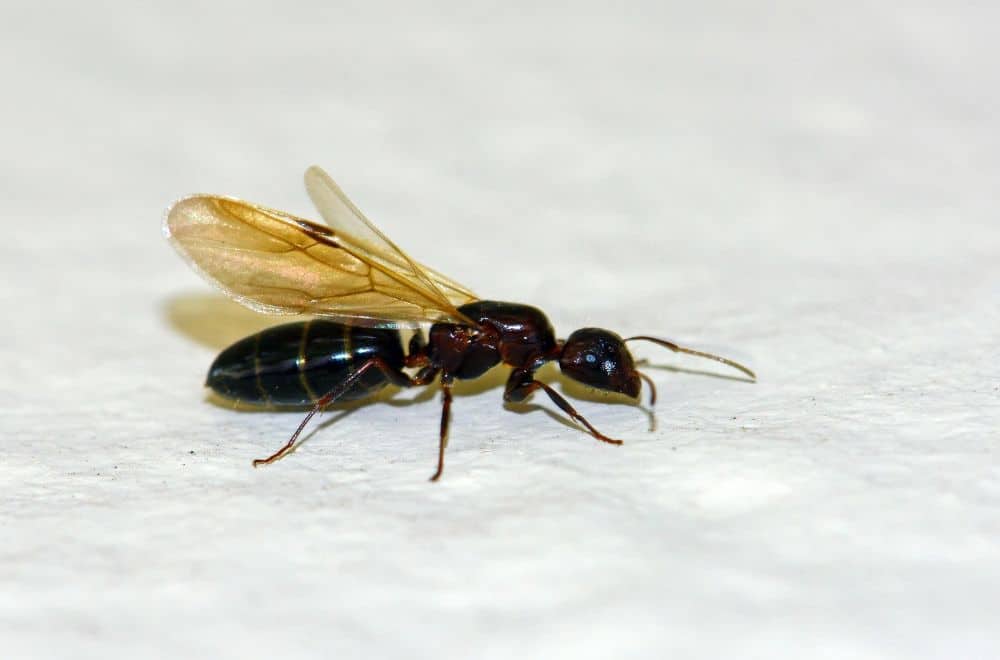
Winged ants are 0.75 inches (19 mm) long insects that typically come in reddish-brown or black color. Unlike other ant species, Alates are a sexually mature, reproductive form with wings, allowing them to fly.
You can see these bugs in your home attracted by light, sweet food, and rotten fruit. When you spot them, you can be sure the colony has been established and contains thousands of winged ants.
They often use open windows to enter houses and find a suitable place for mating. The only solution to get rid of them is to call pest control professionals once that happens.
Ways to Get Rid of Black Flying Bugs

1. Keep your home clean
Frequent cleaning of the entire house will keep some flying bugs far away. For instance, vacuuming and getting rid of food leftovers are efficient ways to eliminate most adult bugs and their eggs.
2. Unclog and clean drains
Unclogging drains, keeping them clean, and fixing even the slightest water leak are efficient ways to prevent and eliminate black flying bug infestation. Some insects choose such places because of slime, bacteria, and fungi buildup. Additionally, thoroughly washing the shower and sink with quality cleaners can be helpful.
3. Seal cracks and gaps and entry points
Small insects often lay eggs inside the wall cracks and gaps. As expected, eliminating these hidden shelters by caulking damaged surfaces will eliminate potential breeding and bug infestations.
Additionally, protecting entry points, like chimneys and air vents, will prevent flying bugs from entering the house. It is essential during the summer and autumn before temperatures start dropping.
4. Inspect old furniture
Always thoroughly inspect and repaint old furniture before entering it into an indoor space to be sure it is insect-free. Otherwise, you can face bug infestation in your home due to their nesting inside the wooden furniture.
5. Turn on the Bug Zapper
As you know, UV light attracts most small flying black household bugs. So, installing the highly effective Bug Zapper will lure them, and the heat will surely kill them. Unfortunately, these devices are often ineffective against biting insects, like Mosquitoes, but can exterminate pollinators, making them a bad option.
6. Vinegar trap
You can try a few non-toxic well-tested methods to eliminate bugs in your home. For instance, make a vinegar trap by pouring cider vinegar into a bowl, covering it with plastic, and poking several holes. That way, you will attract bugs to get inside the bowl and die in the trap.
7. Hydrogen peroxide

Mix hydrogen peroxide with water until getting 3% solution, pour it into a spraying bottle and spray infected areas. You can even use it for protecting live plants.
8. Install wire meshes on windows
Most black flying bugs get inside the house through open windows and doors. Therefore, installing the mesh or screen can be an efficient way to keep insects outdoors. Check them regularly and replace broken parts when necessary.
9. Sticky fly strips
Fly strips look disgusting with all these stuck dying flies, but they are one of the most efficient ways to eliminate flying insects inside your home. Once a strip is overcrowded, you should throw it away.
10. Repot houseplants
If you notice a significant black flying bug infestation, the most practical thing to do is to buy new soil and repot all houseplants inside the house. Let the soil dry, get it off the plant roots, and use a new liner to prevent larvae transfer.
This method is a bit drastic but also highly efficient. Placing rocks at the pot bottom is a proven way to provide proper drainage and prevent new roots from rotting.
11. Place steel wool over the soil
Steel wool effectively prevents bugs, primarily fungus gnats, from flying away after larvae growing in the soil transform into adults.
Place a layer of this cover over the ground around infected plants and create a barrier that will break adult flies’ wings and prevent them from escaping. Be persistent, and larvae will disappear from the soil within a few weeks.
12. Dry the soil
Too-high moisture often leads to plant rotting and decay, attracting many household insects. Once you dry your soil, you will efficiently get rid of these annoying bugs.
13. Remove dead flowers and leaves
In nature, leaves create a layer that decomposes over time and provides necessary nutrients. Unfortunately, it is an entirely different case with house plants.
Removing dead leaves or branches from the pot surface is required to protect your home from harmful bugs. Otherwise, once flowers and leaves fall onto the ground, they become an excellent place for pest feeding and breeding.
Ways to Prevent Small Black Flying Bugs From Returning
Most of the described methods will eliminate black flying bugs from your home, but your goal is to prevent them from returning. Therefore, you should find the best options to get them away in a few ways:
- Regularly clean your home and get rid of old clothes, dirt, rotten plants, and stagnant water
- Ventilate the kitchen and bathroom
- Keep a sink, garbage disposal, and drains clean
- Empty a trash can frequently
- Keep fruits and veggies covered, and store them in a suitable container
Summary
If you spot small black flying bugs in your home but are sure they are not Fruit flies, you can probably face an issue with Fungus gnats or Drain flies. However, they are not the only menaces you can notice. Your only option to eliminate these annoying insects is to identify them and find an excellent repellent or insecticide to stop the infestation.
